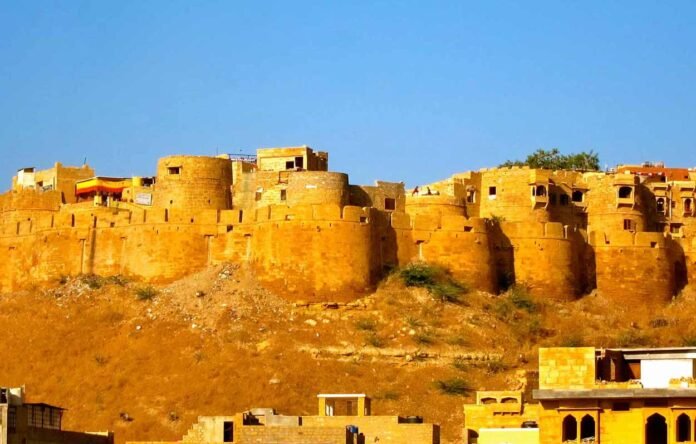Jaisalmer Fort, an architectural marvel in the heart of the Thar Desert, stands as a testament to the rich history and culture of Rajasthan. Known as “Sonar Quila” or the Golden Fort due to its striking yellow sandstone structure that glows in the sunlight, this fort is not just a historic landmark but a living heritage site. Housing shops, temples, residences, and restaurants within its walls, Jaisalmer Fort is a vibrant fusion of history and modernity, making it a must-visit destination for travelers embarking on a Jaisalmer Sightseeing tour.
A Legacy of Valor and Pride
Built in 1156 AD by Rawal Jaisal, the founder of Jaisalmer, the fort is a symbol of Rajput valor and resilience. Strategically located on Trikuta Hill, it served as a key defense point and a trade hub along the Silk Route. Over centuries, Jaisalmer Fort bore witness to numerous battles, each reinforcing the indomitable spirit of its rulers. Its robust walls and narrow passages were designed to deter invaders, and its architectural brilliance reflects a perfect blend of aesthetics and strategy.
The fort narrates tales of legendary Rajput warriors who upheld their honor in the face of adversity. The tradition of “jauhar,” where women and children chose self-immolation over capture by invaders, is a poignant reminder of their courage. These stories of bravery, etched into the fort’s history, continue to inspire generations.
Architectural Grandeur of the Golden Fort
Jaisalmer Fort is a masterpiece of medieval Indian architecture. Its intricate carvings, ornate balconies, and majestic gateways showcase the artistic prowess of craftsmen from that era. The fort has four massive gateways: Ganesh Pol, Suraj Pol, Bhoota Pol, and Hawa Pol, each designed to confuse enemies and protect the inner sanctum.
One of the most striking features of the fort is its 99 bastions that provide stunning views of the surrounding desert landscape. The fort’s architecture is a harmonious blend of Islamic and Rajput styles, reflecting the cultural exchanges of its time. The yellow sandstone, used extensively in its construction, lends it a golden hue during the day, creating a mesmerizing spectacle.
A Flourishing Trade Hub
During its prime, Jaisalmer Fort was a bustling center of trade and commerce. Situated along the ancient Silk Route, it facilitated the exchange of goods such as spices, textiles, and precious stones. The Jain merchants, known for their prosperity and philanthropy, played a significant role in the city’s economic growth. Their contributions are evident in the beautifully carved Jain temples within the fort.
The Jain temples, dedicated to various Tirthankaras, are adorned with intricate sculptures and frescoes, depicting mythological tales and celestial beings. These temples are not only a spiritual haven but also a testament to the artistic and cultural opulence of Jaisalmer.
Life Inside the Fort
Unlike most forts, Jaisalmer Fort remains a living fortress. Around 4,000 people still reside within its walls, preserving the fort’s vibrant heritage. The narrow lanes are lined with shops selling handcrafted items, souvenirs, and traditional Rajasthani attire. Local delicacies, served in quaint eateries, offer a delightful culinary experience, adding to the charm of exploring the fort.
Visitors can also witness the craftsmanship of local artisans creating exquisite leather goods, jewelry, and textiles. This thriving community ensures that the fort remains alive with culture, tradition, and stories from the past.
Experiencing Jaisalmer Fort: Practical Tips
A visit to Jaisalmer Fort is incomplete without immersing oneself in its rich history and vibrant culture. Opting for a reliable Taxi service in Jaisalmer ensures a comfortable journey to this iconic destination. Begin your exploration with the fort’s museums, which house artifacts, manuscripts, and weapons that provide insights into its glorious past. Don’t miss the intricate latticework and stone carvings that adorn the various palaces and temples.
Sunset is the best time to visit the fort as the golden hues of the setting sun illuminate its walls, creating a magical ambiance. Comfortable footwear is essential for navigating the uneven pathways and narrow alleys. A guided tour can enhance your experience, as local guides bring the fort’s history to life with captivating stories and anecdotes.
Preserving the Legacy
In recent years, efforts have been made to preserve Jaisalmer Fort’s heritage. Its inclusion in UNESCO’s list of World Heritage Sites highlights its cultural and historical significance. However, challenges such as erosion, unregulated tourism, and modern construction within its precincts pose threats to its survival. Local authorities, along with conservation experts, are working to address these issues while ensuring the livelihood of the fort’s residents.
By visiting Jaisalmer Fort responsibly, tourists can contribute to its preservation. Supporting local artisans, adhering to guidelines, and respecting the fort’s heritage are small yet impactful steps toward safeguarding this historical treasure for future generations.
Conclusion
Jaisalmer Fort is more than just an architectural marvel; it is a living narrative of valor, trade, and cultural richness. Its golden walls echo tales of bravery, its temples showcase artistic brilliance, and its thriving community keeps the fort alive. A visit to this iconic landmark offers an unparalleled glimpse into the soul of Rajasthan. Whether you are a history enthusiast, an architecture admirer, or a culture seeker, Jaisalmer Fort promises an experience that lingers in your memory forever.



